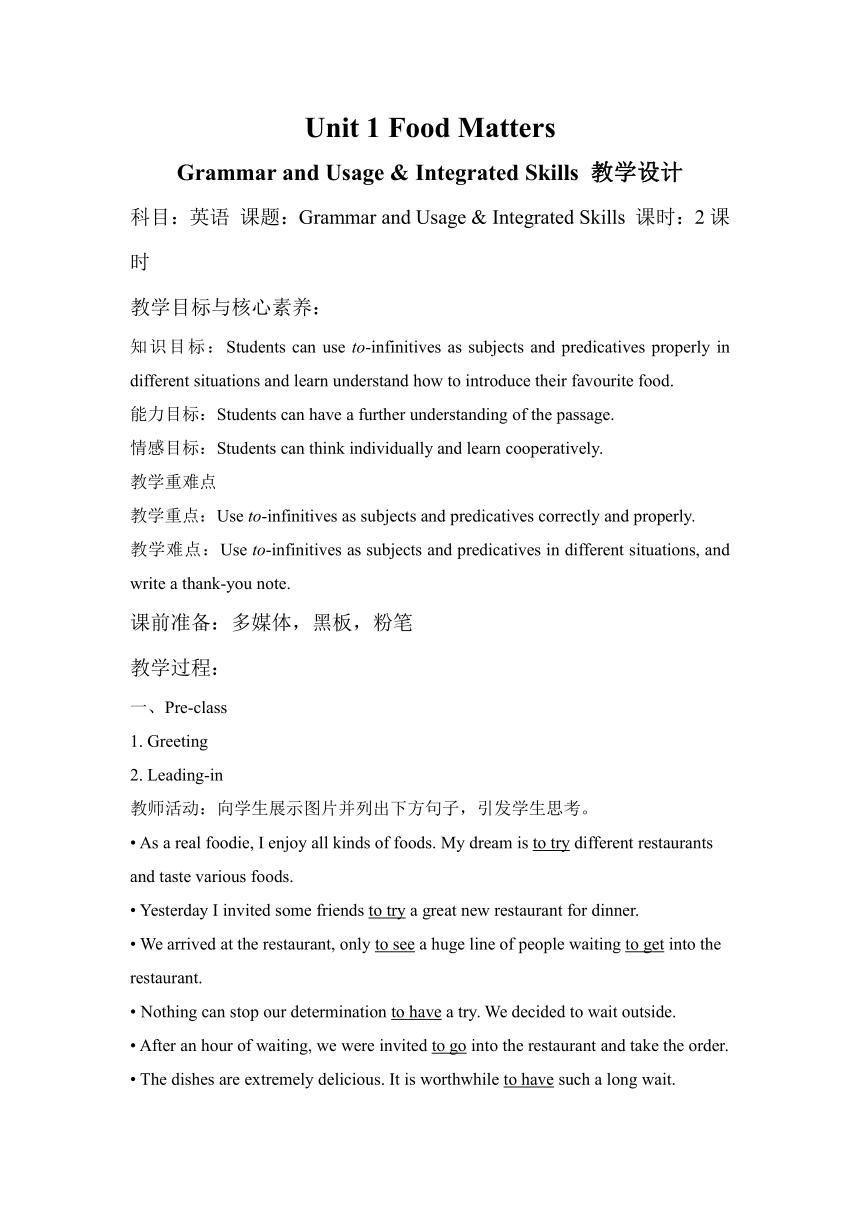
Unit 1 Food Matters Grammar and Usage & Integrated Skills 教学设计 科目:英语 课题:Grammar and Usage & Integrated Skills 课时:2课时 教学目标与核心素养: 知识目标:Students can use to-infinitives as subjects and predicatives properly in different situations and learn understand how to introduce their favourite food. 能力目标:Students can have a further understanding of the passage. 情感目标:Students can think individually and learn cooperatively. 教学重难点 教学重点:Use to-infinitives as subjects and predicatives correctly and properly. 教学难点:Use to-infinitives as subjects and predicatives in different situations, and write a thank-you note. 课前准备:多媒体,黑板,粉笔 教学过程: 一、Pre-class 1. Greeting 2. Leading-in 教师活动:向学生展示图片并列出下方句子,引发学生思考。 As a real foodie, I enjoy all kinds of foods. My dream is to try different restaurants and taste various foods. Yesterday I invited some friends to try a great new restaurant for dinner. We arrived at the restaurant, only to see a huge line of people waiting to get into the restaurant. Nothing can stop our determination to have a try. We decided to wait outside. After an hour of waiting, we were invited to go into the restaurant and take the order. The dishes are extremely delicious. It is worthwhile to have such a long wait. 学生活动:阅读P6的博客,找出其中的不定式结构。 Exploring the rules to-infinitives as subjects To eat out was also a social activity, allowing me to enhance the relationship with my friends. When I picked a popular recipe and gave it a try, I discovered that it was not that difficult to make a simple and tasty dish. to-infinitives as predicatives Not that long ago, my first thought at mealtimes was to eat at a restaurant. My plan is to invite my friends over at the weekend to show them my new-found skills. 学生活动:完成课本活动Working out the rules。 When the to-infinitive is used as a subiect, we usually use the preparatory subject (1)_____ at the beginning of the sentence. The to-infinitive can also be used as a predicative. It usually comes after the verb (2) _____. (Suggested answers: (1) it (2) be) 二、While-class 教师活动:详细介绍动词不定式作主语和表语的规则。 一、动词不定式的时态和语态 时态 语态 主动 被动 一般式 to do to be done 进行式 to be doing 完成式 to have done to have been done 二、动词不定式作主语 1.动词不定式作主语时,一般表示具体的或一次性的动作。作主语的不定式有时态和语态的变化,且谓语动词通常用单数。 To finish this job in one day is impossible. 要在一天之内完成这项工作是不可能的。(表示具体的情况) 注意:很多情况下,作主语的动词不定式都可以用动名词替代,但表示某些具体情况,或表示较强烈的对比,或在某些固定说法中时,通常不用动名词替代。 To err is human.人非圣贤,孰能无过。 To know everything is to know nothing. 样样皆通,样样稀松。 2.若不定式太长,则往往用it代替不定式作形式主语,不定式移至谓语之后,以使句子结构平衡。其常见句型有以下4种: (1) It +be+形容词+(for/of sb.) to do sth. (2) It+be+名词+ to do sth. (3) It takes (sb.) some ... ...
~~ 您好,已阅读到文档的结尾了 ~~